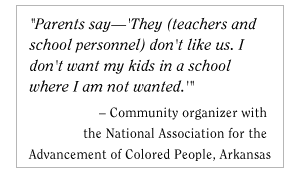|


 here
you hold your community forum matters. Some participants may feel
more comfortable in informal locations, like someone's home or a
neighborhood restaurant. Other participants with strong religious
convictions may think meeting in a church or temple is inappropriate.
Still others are at home in these settings. Some participants may
have concerns about meeting in a governmental building, fearing
contact with immigration officials. here
you hold your community forum matters. Some participants may feel
more comfortable in informal locations, like someone's home or a
neighborhood restaurant. Other participants with strong religious
convictions may think meeting in a church or temple is inappropriate.
Still others are at home in these settings. Some participants may
have concerns about meeting in a governmental building, fearing
contact with immigration officials.
These considerations may leave organizers asking: "Well, where
should we meet?"
The bottom line is: know your community. The fact is any one of
the options above may work well, it's just knowing which one is
a good fit. Enlist community leaders to help identify the most appropriate
meeting locations. Canvass the neighborhood for good locations and
ask leaders for ideas. Neutral places such as a community or recreation
center may work best.
Other issues to think about include the safety of participants.
Is the designated meeting site in a safe area? If not, could it
be made safer? Also be sure the location is close to where participants
live, and has access to public transportation. Provide transportation
if the meeting site is not on a bus line. If you are planning a
city-wide community forum, identify transportation strategies that
ensure all segments of the community can attend and are well-represented.

Logistics largely cover meeting times, transportation, childcare
and food.
Setting meeting times largely depends on the community. Find out
what works best for participants. Consider holding a series of meetings
on the same issue at different times to accommodate as many family
and community members as possible. Learn which cultural celebrations,
religious observances and holidays conflict with meeting times.
 |
 |
 |
Sometimes a school is not the best place to
hold a community conversation, especially if parents have had
bad experiences in the past: |
 |
 |
 |
| |
|
Lack of transportation continues to hinder the involvement of many
low-income, minority parents and community members. Is public transportation
available? If not, arrange for private transportation, car pooling
or "walking pools" which involves groups of neighbors who walk together
to an event.
Many of the organizers interviewed by SEDL stressed the importance
of providing child care. Let participants know ahead of time whether
on-site childcare will be provided.
Refreshments, including food native to participants' cultural backgrounds,
is a good ice breaker. And, often participants don't have an opportunity
to eat or a grab a snack before they attend a community meeting.
|